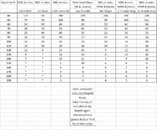Over the years, past threads have pointed out that in a typical scuba course, we spend a lot of time dealing with the dangers of decompression sickness. As I mentioned earlier, the way we taught and used tables emphasized the danger of exceeding NDLs for even one minute. [....]
I briefly mentioned the dive buddy I had who made a panicked ascent when he saw his computer was getting near deco. I wonder how many fatalities were caused when people saw they had reached their NDLs and had to get to the surface in a hurry to prevent the horror of straying into deco.
Not many I'd think. DCS is a very intangible, non-instinctive risk psychologically. There's no direct 'trigger' to our fight or flight instincts. Very unlike, for instance, having no breathing air, flooding a respiratory passage with water, or even seeing predatory marine life.
A decision to ascend quicker than optimally due to numbers on a computer screen is an error in comparative risk analysis. It's an intellectual process, albeit a flawed one, not an innate self-preservative reaction.
I agree with Boulderjohn, though. When I'd finished OW and AOW (PADI) here in Canada in 1998, I had *no idea* about staged decompression. The facts drilled into me were that DCS can maim or kill you. And that to go over NDL, by even a minute, was, therefore, potentially going to maim or kill me. Because I had not seen a decompression table, I had no idea one could spend x minutes at y depth during decompression and so on. (Of course, I had no idea how to calculate gas consumption, or hold a stop in the water column for x minutes without drifting up or down either, some of the things you need to have a firm grasp on to do decompression diving).
Because I'm detail oriented, I used to get anxious as NDL approached, and a number of times went up ten or twenty feet above buddies who were not so observant of their computers.
No so good for buddy protocol, but I didn't want to get bent. My then incomplete knowledge of how deco diving was performed led me to think only of maiming and death as those numbers got closer to zero on my computer. On top of this, I had no idea what my computer looked like if it went into deco, and no idea of what to do if it did, or how to interpret what it said. It was just a black hole of doom to be avoided at all costs.
Over the years I have seen divers bolt to the surface as they approached deco. They had no idea of what to do either as those NDL numbers got to 3, 2, 1....other than go up quickly.
And that can become an uncontrolled ascent. Especially in a drysuit. It didn't matter that responding to the numbers by quickly ascending was a "flawed intellectual process", they still went up dangerously quickly. Think embolism potential.
*****
When I took decompression training, in my first actual planned deco dive, as I watched my computer tick over 0 NDL and I read the word DECO, *even though I was in decompression training*, I still had that little voice from OW/AOW saying "you're gonna die, go up now". Of course, I did not.
*****
By providing little
to no practical education in OW/AOW about what to do when you (accidentally or on purpose) go really close to or over NDLs, there is definitely a subset of people who will make a panicky choice to go up quickly if that occurs, with the potential of an uncontrolled ascent and the dangers of embolism.
This leads me to another point about training. The blanket theoretical proclamation on an OW/AOW table of stay 8 minutes at 15 feet (or whatever) if you exceed NDL doesn't cut it if these skills have never been practiced.
Do you know how much gas you need to hang out there at 15 ft? Are you properly weighted for that 15 ft stop; realizing that as you use up gas normally, you lose the weight of the gas and become more buoyant?
If you've just got stressed as you approach or exceed NDLs you breathe faster. Rapid, stressed breathing holds more gas in the lungs, and uses more gas, both of which increase buoyancy, making that 15 ft stop even harder to hold. That in turn causes stress as you struggle to hold your depth (if not properly weighted), in a cycle that can pop you up to the surface in no time.
How can you hold that stop for 8 minutes, without going above 15 ft with, say 800psi, if you've never practiced in a *benign* situation? OW/AOW training should encompass this benign scenario IMO, instead of it being a theoretical thing on a table, to do if you blow that NDL.




